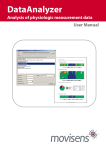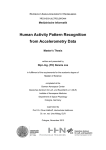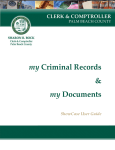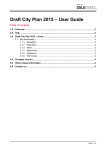Download ORDA - User's Guide - v3 - State Records Office of Western Australia
Transcript
SRO| State Records Office of Western Australia Online Retention & Disposal Application (ORDA) User Manual November 2013 www.sro.wa.gov.au Table of Contents 1. Introduction ................................................................. 3 2. Glossary ...................................................................... 4 3. Getting started............................................................. 5 4. Editing your disposal authority .................................... 7 5. Drafting you disposal authority .................................. 10 6. Importing your disposal authority .............................. 19 7. Searching for precedents .......................................... 22 9. Adding comments ..................................................... 26 10. Exporting your disposal authority .............................. 28 11. Submitting your disposal authority ............................ 29 12. Troubleshooting ........................................................ 31 ORDA - User Guide – November 2013 -2- 1. Introduction About the Online Retention and Disposal Application (ORDA) ORDA is a secure, web-based system to process the drafting and submitting of your organisation‟s disposal authority (e.g. Retention and Disposal Schedule). Through ORDA, you can: Use the standard template provided to prepare / draft your disposal authority; or Import your disposal authority if prepared using other software tools. Export your disposal authority in different formats, including as a Word document with traditional look; Search across other approved disposal authorities for existing precedents. The State Records Office (SRO) will review your draft authority within ORDA and mark any comments against it. In this way, collaboration between you and the SRO to progress your disposal authority from draft to final approval can be conducted entirely through ORDA. About this Guide This Guide provides step-by-step guidance in developing and submitting your organisation‟s disposal authority. System requirements You can access ORDA through any modern web browser – you do not need to download any software to access the system. NB: If you are using Internet Explorer you will require version 7 or above for ORDA to display properly. Once you are logged into the system, if there is a 30 minute period of inactivity you will be logged out. You will need to log in again to proceed. Contact details SRO Recordkeeping Services team [email protected] ph. 9427 3661 ORDA - User Guide – November 2013 -3- 2. Glossary The purpose of this glossary is to explain the meaning of certain elements within ORDA. Element Description Activity Business activities are what an organisation does to carry out its business functions. Taken together, a group of activities will make up a business function. These activities do not overlap, although parts of them may be done by different business units within the organisation. Class Disposal classes consist of records performing or recording similar transactions and therefore have (generally) the same retention period and disposal action. In ORDA, sentencing of records (i.e. assigning retention periods and disposal actions) is done at the class level. Classes are identified in ORDA via the icon. Context Context elements assist decisions within a disposal authority to be understood by documenting the wider organisational, legal and administrative framework in which disposal decisions are encompassed. In effect, this forms the introduction of a disposal authority. Disposal Authority Each WA government organisation is to retain and dispose of its records in accordance with an approved disposal authority. Disposal authorities can take the form of General Disposal Authorities, Sector Disposal Authorities, Retention & Disposal Schedules, Ad Hoc Disposal Authorities and Disposal Lists. Function A Function is a specific responsibility or obligation an organisation is assigned (to perform) by legislation, policy or mandate. Retention & Disposal Schedule A Retention and Disposal Schedule (R&D) is a disposal authority that covers a government organisation‟s core business records. Term Terms are keyword elements within which Classes belong. Terms effectively contextualise classes and their disposal decisions. A term may be a function, an activity, a series, a subject or another generic element in which Classes will form units of. Terms are identified in ORDA via the ORDA - User Guide – November 2013 -4- icon. 3. Getting started Please contact the SRO before you commence preparing your organisation’s disposal authority. The SRO will register all relevant details in ORDA and you will then receive an email notification containing a link to the system which lets you activate your user account. The email notification contains your user name but you will need to set your own password to access ORDA. Your password must be at least 8 characters long. The system provides a password strength meter. Using a password that contains a mix of letters, numbers, lowercase/uppercase, symbols, etc will typically provide a more secure password. It is recommended that you choose a password of at least MEDIUM strength. For security reasons, your password cannot be retrieved from the system. If you forget your password, please contact the SRO. You can access ORDA through the SRO website at: https://orda.sro.wa.gov.au To log into the system, click on “Client Log On” in the top right hand corner of the screen: ORDA - User Guide – November 2013 -5- Enter your user name and password: Once you have logged on, you will automatically be taken to the screen in which you can access any disposal authorities assigned to you. If at any stage you wish to change your password, click on your name in the top right corner of the screen: Then click the “Change password” button: You can now enter your new password and save it: ORDA - User Guide – November 2013 -6- 4. Editing your disposal authority Click on the “Disposal Authorities” tab to see the table of disposal authorities (or disposal authority) allocated to you. Click on the “Edit DA” link: This will lead you to the screen in which you can draft or import your disposal authority: ORDA - User Guide – November 2013 -7- The top part of this screen provides the basic registration details for your disposal authority, as well as the version number and the date it was last updated: To collapse this section, click on the “- Details” link. This is recommended while you are drafting your disposal authority as it will provide more usable screen space. Clicking on the “+ Details” link will expand this section again. Selecting “F11” on your keyboard will also allow ORDA to display full screen which will assist maximising screen size even further: If you are importing a disposal authority, this can be done via one of the import options. See Section 6 of this Guide for instructions on importing a disposal authority: As you develop your disposal authority, you may review it as a single table by clicking on the “Review DA” button. Further information about reviewing your disposal authority is in Section 8 of this Guide. ORDA - User Guide – November 2013 -8- There are three main “nodes” to the disposal authority template as displayed in the tree menu in the left hand panel: Node Description Disposal Authority This provides the title of the disposal authority. The SRO will also provide general comments about the authority at this level when it is reviewed. Context This provides the context of the disposal authority. Background information about the organisation, the scope of the authority and any disposal protocols will be documented at this level. The SRO has pre-populated the main Context elements although you will need to update these where specified. Terms/Classes This constitutes the main body of the disposal authority. Information about the functions, activities, etc. of the organisation - as well as disposal classes resulting from these – will be documented at this level. At the Class level, you can specify retention and disposal decisions for groups of records. ORDA - User Guide – November 2013 -9- 5. Drafting you disposal authority Updating Context The first part of drafting your disposal authority involves updating the Context (i.e. Introduction) elements. These elements can be opened by clicking on the ► symbol next to “Context”: Click on each Context element via the tree menu and update the “Description” in the text box where indicated. Click on the “Save” button to save your updates: NB: Some of the Context elements contain standard text and will not need updating. ORDA - User Guide – November 2013 - 10 - If required, you can add new Context elements to provide further background information to your disposal authority (generally, this will not be required as the existing elements will be sufficient for most authorities). To add new Context elements, right-click “Context” in the tree menu and then select “Add Context”: The new Context element will be placed as the last element in this node (although you can move its position via drag and drop). You will need to give the new Context element a title, choose the “Context Type”, complete the “Description” and then click “Save”. Adding Terms and Classes After completing the Context elements, you can now start to build the body of your disposal authority at the Term/Class level. Add options Description Add Function Activity - Class Most disposal authorities will conform to the Function-ActivityClass structure. Selecting this option will automatically “nest” the Activity within the Function, and the Class within the Activity. Add Term This option will add a single Term (e.g. a Function, an Activity, etc.) as a first-level term. Add Class This option will add a single Class as a first-level class. ORDA - User Guide – November 2013 - 11 - To add Terms/Classes, right-click “Terms/Classes” in the tree menu: Adding a Function-Activity-Class option will automatically create this nested structure as follows: Once Terms/Classes are added, Terms/Classes at the „same‟ level or at the „next‟ level down can be added by right-clicking the appropriate Term/Class and making a selection: ORDA - User Guide – November 2013 - 12 - “Add Term” should be used when adding multiple activities that are part of a given business function. “Add Class” should be used when adding multiple disposal classes that are part of a given activity. Selecting “Copy” will place the same Term or Class at the same level as that which is being copied. This can be used when wanting to re-use an existing description or to use that as the basis for further editing. Once a Term or Class has been copied, it can also be moved elsewhere in the tree menu. If you wish to remove a Term or Class, right-click that entity and choose “Delete”. This will however remove any Terms/Classes that are nested within that entity. You can move any Terms/Classes within the tree menu by clicking on the Term/Class and, keeping your finger on the mouse, dragging it to where you wish to place it elsewhere in the tree menu. Using drag and drop will move any elements which are nested a Term and will automatically re-sequence the numbering order for all Terms/Classes. In summary, although a three-tier structure of Function-Activity-Class will be the typical structure for a disposal authority, there is flexibility to create other structures when required. Describing Terms When Terms are added via the tree menu, you need to provide further information about them in the corresponding form: ORDA - User Guide – November 2013 - 13 - Provide each Term with a title and description. Text in the description can be bolded, italicised, underlined, numbered or dot pointed if required. ** See References pending – functionality will be available c. Dec 2013 ** You can use the “See Reference” to provide a cross reference from this term to: A Term/Class in the General Disposal Authority for State Government Information produced by the SRO, or Another Term/Class elsewhere in the organisation‟s disposal authority. To do this, click “Add” in “See” Reference. You will then need to select whether you are linking to a General Disposal Authority or making a custom link: When linking to a General Disposal Authority, select the appropriate authority and then the Term in that authority you are linking to: ORDA - User Guide – November 2013 - 14 - Once you select save, the cross reference will be captured: When the disposal authority is exported as a Word document this cross reference will appear within the Term description. Describing Classes and Determining Disposal Decisions You will need to provide each Class with a description. Providing a title for Classes is optional. Text in the description can be bolded, italicised, underlined, numbered or dot pointed if required. Each Class requires disposal decisions, which specify what will happen to the records. To enter disposal decisions, click “Add” in the Disposal table: ORDA - User Guide – November 2013 - 15 - For the retention period, enter the (minimum) number of years or months the records will be retained and choose “years” or “months” from the drop down menu. For the disposal trigger, choose from the generic triggers in the drop down menu or enter your own specific trigger as free text (there is no need to include “after” in this field as the system will insert this automatically). For the disposal action, select the appropriate action from the drop down menu: Once you click “Save”, the custody information will automatically be expressed as a single statement. The disposal decisions can at any time be edited, deleted or added to: ORDA - User Guide – November 2013 - 16 - Custom Disposal Decisions In most cases you will only need to specify the retention period, the disposal trigger and the disposal action. However, customised disposal decisions can be used if required. Adding a Disposal condition allows for disposal decisions to suit specific circumstances. This would occur when there are two (or more) different disposal decisions that apply to the same class of records. This option would however rarely be used. The usual approach which SRO recommends is to provide two (or more) Classes, each with a single disposal decision. A Custom disposal decision can be used in three ways: Custom options Description Transfer In situations in which records are transferred to a 3rd party once the retention period has expired, the receiving entity should be stated in the “Transfer To” field. NB: This is NOT to be used when the transfer of State archives will be made to the SRO. Custom Action If the records are subject to a disposal action not listed in the main disposal action menu, a customised action can be entered in the “Custom Action” field. Custom Custody If the records require a custom custody, this can be stated in the “Custom Custody” field. This would typically be used when records are identified as State archives but which will be retained permanently within the organisation. ORDA - User Guide – November 2013 - 17 - Disposal Justifications The Disposal Justifications table allows information that supports disposal decisions to be provided. The Archival Justification drop-down list is intended to criteria against which decisions to archive records can be benchmarked against. These criteria are not currently available in this table, but you can use the free text field to justify any decision to destroy or archive classes of records, to note any changes in disposal decisions from a previous schedule, etc. Optional Elements Element Description “See” Reference It is possible to add “See” References at the Class level in the same manner as at the Term level. However, this cross referencing is typically conducted at the Term level and is not recommended at the Class level. Restricted Access Notes You can state if a restricted access status should apply to any class of records identified as State archives. To enter a restricted access justification, click “Add” in the “Restricted Access Note” table and choose which section of the State Records Act 2000 the restriction is being made under. You can enter a free text justification in the “Description” field to further clarify why a restriction should apply. The “Export Restricted Access” report will document all restrictions made. Links You can link classes from your organisation‟s disposal authority to classes of another authority. This is intended to be used when one disposal authority supersedes another and you wish to link the changes in disposal decisions. The “Export Linking” report then provides a table that documents these links. NB: this functionality will not be required until the system is more fully populated with disposal authorities and they become superseded by newer authorities. Copying / pasting text into Description fields Copying / pasting from existing documentation (e.g. Word or PDF documents) directly into the Description fields in ORDA can result in formatting errors. The SRO strongly recommends that this not be conducted. If needing to copy / paste text from existing documentation, the SRO recommends that the text be copied and saved as a Plain Text document first, without any formatting being applied. The Plain Text can then be copied, without line breaks, into the relevant Description fields in ORDA. Line breaks and rich text formatting should be applied in ORDA after the text has been copied in. ORDA - User Guide – November 2013 - 18 - 6. Importing your disposal authority If you have already prepared your disposal authority using desktop or 3rd party software, you can import this into ORDA rather than using the template to manually draft your authority. You can import your authority in either XML or CSV format. To conduct an import, navigate to the Edit Disposal Authority screen and click on “Import Options” and select how you want to import your authority: XML Import When importing a XML file, the import must accord with the XML Schema which can be viewed by clicking the “Download XML Schema” link via the Import XML screen: To proceed with the import click “Browse” to select the XML file you will be importing and then click “Upload file”. NB: If your XML import does not accord with the Schema your data may not import correctly. ORDA - User Guide – November 2013 - 19 - CSV Import Alternatively, you can import a disposal authority in CSV format. This is likely to be a better option if you have already prepared your disposal authority in Word or Excel. When importing a CSV file, the import must accord with the structure of the CSV template which can be viewed by clicking the “Download CSV Template” link via the Import CSV screen: In importing a CSV file, the following steps are recommended: Download the CSV template and save this locally; Copy and paste your disposal authority data into the template you have saved; Click “Browse” to select your populated CSV file; Click “Upload file”. NB: If your CSV import does not accord with the template your data may not import correctly. The following screen shot shows how you should set out information for you CSV import. You will need to repeat function and activity information in those rows when multiple classes assigned to a single function or activity: ORDA - User Guide – November 2013 - 20 - It is also recommended that you use the exact wording for the disposal actions, the options being as follows: Destroy Required as State archives Retain in agency Transfer This will ensure that when the CSV file is imported, the custody statements are correctly expressed. Unless you are experienced in using XML or have an XML editing tool, importing a disposal authority as a CSV file is likely to be a better option. NB: When you conduct an import, this will overwrite any data that is currently at the Term/Class level. Context information will however remain intact. ORDA - User Guide – November 2013 - 21 - 7. Searching for precedents To assist informed and consistent decision-making, ORDA can be searched for existing precedents from approved disposal authorities in the system. NB: ORDA is being populated progressively as new disposal authorities are developed. More disposal authorities will be searchable across the system over time. A search can be conducted on specific organisations, government sectors or disposal authorities as well on Terms/Classes across approved authorities. Searching can also be conducted by using a combination of search fields: Search results are presented in several ways. You can view the whole disposal authority in which a matching result has been found by clicking on the link in the “DA Title” column: ORDA - User Guide – November 2013 - 22 - You can view the specific matching result within the disposal authority by clicking on the link in the “Term/Class” column: You can view a snapshot of the matching result within the disposal authority by clicking on the link in the “More info” column: ORDA - User Guide – November 2013 - 23 - You can view a consolidated report of matching results by clicking on the “Report” button: In this latter example, you can export the report in different formats such as a spreadsheet by clicking on the icon and choosing your preferred format. This is a recommended option when there is a large number of matching results – the data can then be analysed and refined further via the spreadsheet: ORDA - User Guide – November 2013 - 24 - 8. Reviewing your disposal authority You can review your disposal authority by clicking on the “Review DA” button: This will lead to a screen in which the body of your organisation‟s disposal authority will be set out in a single table: Any errors in Term/Class descriptions can be amended via this screen by clicking the icon. More substantial editing/correcting will need to be done via the Edit Disposal Authority screen. There are links back to the relevant sections in the Edit screen in the “No.” column. ORDA - User Guide – November 2013 - 25 - 9. Adding comments As you develop your disposal authority you can add comments against specific sections of your authority if you wish to highlight something or seek clarification. Comments can be added via the Edit screen by selecting the item in the tree menu (left panel) against which you wish to leave a comment and clicking “Add” in the Comments table: A free text field will display in which you can add your comment: Once you save your comment, this will be captured into the Comments table which will automatically log who added the comment and when. You can edit / delete your comments although you cannot edit / delete comments made by another user or after you have submitted your disposal authority to the SRO. ORDA - User Guide – November 2013 - 26 - When a comment is made, a red star will also appear against the commented item in the tree menu as a special alert for commented items: You can also add comments via the Review screen by clicking on the adding your comment: ORDA - User Guide – November 2013 - 27 - icon and 10. Exporting your disposal authority At any stage, you can export your disposal authority in various formats, as well as export discreet reports on Comments, Disposal Justifications, Restricted Access Archives and Linked data: You can do this via the Edit screen by clicking the “Export Options” button and then selecting the format / report you want to export. Selecting the “Export DA (Word)” option will produce your disposal authority with the traditional look. ORDA - User Guide – November 2013 - 28 - 11. Submitting your disposal authority Once you have completed drafting your disposal authority and you are ready to submit it to the SRO for review, navigate to the Edit screen and click the “Submit” button: This will take you to the Disposal Authority Workflow screen. Click the “Submit to SRO” button: Once this has been done, your disposal authority has been submitted to the SRO for review. The system will send you an email notification confirming this. The SRO officer assigned to your disposal authority will conduct their review. While this process is being undertaken, you will not be able to make any updates to your disposal authority. As the SRO conducts its review, the SRO officer will add comments to any items that need further clarification or amendment. These will be marked up against your disposal authority (as the next version). When the SRO review has been completed you will receive an email notification informing you of such. You can then log back into the system to access your reviewed disposal authority. ORDA - User Guide – November 2013 - 29 - In making further amendments to your disposal authority, you need only focus on those items that are identified with a red star. The red stars identify where the SRO has made comments and where something in the Term/Class will need further clarification or amendment. In providing clarification, you can also add you own comments. When you have addressed all matters that the SRO has commented on, either by amending the sections as appropriate or by providing additional clarification, you can submit your disposal authority again in the same way as you did previously. Some disposal authorities may need to go through several iterations to reach a stage of finalisation, but often just one stage of revision is required. Once the SRO is satisfied that the disposal authority is ready to be submitted to the State Records Advisory Committee (SRAC) for independent review, the SRO will progress this through the system‟s workflow and you will receive a notification of such. If the SRAC requests that further changes be made to the authority, the SRO will identify these sections via ORDA and you will receive a further email notification to log into the system and address these items. Again, such items will be identified with a red star so you only need focus on these. After amending your authority, you will need to submit it as per above. Upon SRAC endorsement, the next stage in the workflow is for your disposal authority to be submitted to the State Records Commission for approval. Once approved, the SRO will write to your organisation confirming that your disposal authority has received legal sanction. Typically, once your disposal authority is approved by the State Records Commission, your access to ORDA will be deactivated. When it comes time for your disposal authority to be reviewed (within 5 years of the date of approval) there will be an option to use the existing disposal authority within ORDA as the basis to make further amendments if required OR to use a blank template. ORDA - User Guide – November 2013 - 30 - 12. Troubleshooting If you cannot connect to ORDA, please contact the SRO officer assigned to review your disposal authority. If you experience difficulty in exporting the Word version of your disposal authority, this will invariably be due to text in the (Context / Term / Class) Description fields containing formatting errors. Formatting errors can occur if text has been directly pasted into these fields from existing documentation (e.g. Word of PDF documents). The SRO strongly recommends that this not be conducted. Please refer to the end of section 5 in this document for advice on pasting text from plain text files. When text in a Description field does contain a formatting error, an error message will be displayed on screen when exporting the Word version of the disposal authority. This message will identify what section of the disposal authority contains the error and provides a “View” link to navigate straight to that section. Formatting errors are often self-evident. The Description text in this section should be removed. The text for this field should then be typed directly into ORDA and any formatting applied via the rich text options available in ORDA. This will ensure formatting errors are corrected and that the Word version can be exported properly. *********************************************************************************** Should you experience any difficulties using ORDA at any stage, please contact the SRO officer assigned to your disposal authority. *********************************************************************************** ORDA - User Guide – November 2013 - 31 -







































